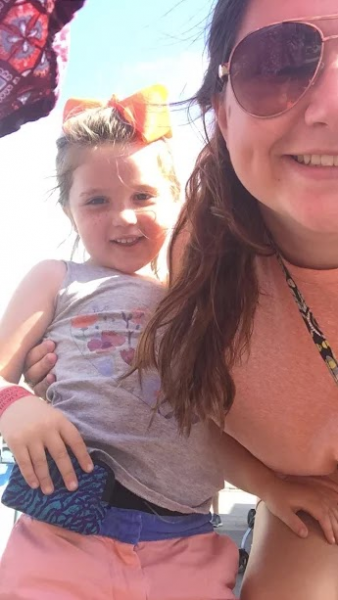Shared diabetes journeys

By Rayna Zimmerman
My sister was diagnosed with type 1 diabetes at the age of six; I was sixteen then. My daughter was diagnosed at the ripe age of four; that time, I was 27.
To say diabetes plays a big role in my life is an understatement. You see, my mom was a single mom who worked nearly an hour away from home, which meant a lot of the responsibility for taking care of my sister fell on me as the oldest sister. I spent a lot of time treating, correcting, and checking blood glucose levels.
Fast forward ten years and people start joking that my daughter acts just like her Auntie Micah at that age. That was their polite way of saying that Hayden was typically mean, as Micah was prior to diagnosis. I played it off, thinking she was a spoiled only child, and I needed to up my parenting game. Soon the dark circles under her eyes began to take shape, and the lethargy started to set in. And while a million illnesses crossed my mind, diabetes didn’t because diabetes wouldn’t happen to my child—or so I thought.
One night she started vomiting, and the contents looked so strange that I took her to the hospital, as I was certain she had a blockage. They released us rather quickly and assured me it was just a virus. And I listened. If you’re reading this, you probably know how dangerous that could have been. We were lucky that it wasn’t. Three weeks later she started having accidents, so off to the doctor we went. We needed antibiotics for the urinary tract infection she obviously had. We left with a prescription, but it wasn’t long before I got the call to come back because they found sugar in her urine.
I was certain the sample was just contaminated (remember, we were just dealing with a mean four-year-old), but I assured the doctor I would check her blood sugar when we arrived at home. I ran to my mom’s house, conveniently two houses down from mine, and grabbed a meter. I had Auntie Micah check her sugar first so that Hayden knew what was coming, and then I pricked Hayden. The meter read 455. Oops! I forgot to wash her hands! Rookie mistake. We washed and tested again—479. And it hit me.
My child, my just-turned-four-year-old baby, had diabetes.
But, while diabetes plays a huge role in my life, this isn’t about me. It’s about Micah and Hayden.
So, fast forward with me again a couple of weeks. My daughter, who is now on insulin, is still mean and cranky. I’m so confused as to why. Luckily, our Dexcom (which we ordered the day of diagnosis and wasn’t readily available when Auntie was little) arrived! And then I finally understood.
Hayden’s blood sugar was spiking to 300 and over multiple times a day. I would probably be irritated at life, too! Thus, the research began. I’ve spent hours upon hours researching, asking questions, and trying (and sometimes failing at) new techniques.
Unfortunately for Micah, we didn’t know that there was more at play than the number of carbs consumed. We didn’t know that the fat in a meal can encapsulate the carbs and cause a high later, and we definitely didn’t know how to counter that or use it to our advantage. We didn’t know that less insulin over an extended period of time could work better than a large bolus, nor that pre-bolusing would help to prevent a spike.
Now that we know all of these things, both girls feel better, and my daughter has her happy demeanor back. I use Dexcom to monitor trends and make adjustments as necessary. For example, pizza not only has a lot of carbs, but also a lot of fat. This causes a low shortly after consumption (if the full amount of insulin is given at meal time) and a high later when the fat has burned off, and the carbs kick in again.
Monitoring the trend has taught me that I can do an extended bolus on her pump to give her 30% of the bolus immediately and extend the remaining 70% over the next four hours. This means that for four hours, the pump is slowly giving her insulin to counter the pizza she consumed several hours earlier.
Speaking of fat, because I have the ability to monitor trends on Dexcom, I’ve learned to use the fat component to my advantage. Fruit, especially melon, spikes Hayden almost immediately regardless of a pre-bolus unless I pair it with something high in fat, like an avocado. This allows her levels to remain steady and within normal range while the extended bolus is at work. Having a CGM has also allowed me to determine how early I need to pre-bolus for certain foods.
For example, in the morning if she is having her normal toast, eggs, avocado, and fruit, I bolus her right before she starts eating. If not, she drops too low before the carbs kick in. If she is eating something high in sugar, like waffles, I know I need to pre-bolus about 45 minutes early, as the amount of sugar causes an immediate spike. I need the insulin to take effect prior to her eating.
Monitoring the Dexcom trends and making adjustments based on those trends has allowed us to stay within range the majority of the time, which for us is between 70 and 140. Of course, diabetes doesn’t always play fair, and sometimes insulin works like water. Or there isn’t time for a 45-minute pre-bolus because a mom in her Pre-K class brought impromptu snacks. However, for the most part, a CGM like Dexcom allows us to live our lives as happy as we ever were.
